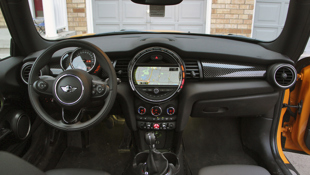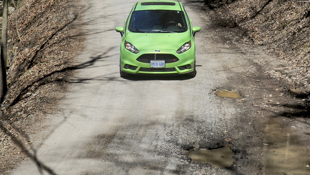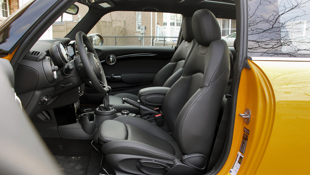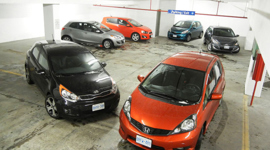Comparison Data
|
Base Price
$25,490
|
$24,999
|
|---|---|
|
A/C Tax
$100
|
$100
|
|
Destination Fee
$1,655
|
$1,550
|
|
Price as Tested
$33,365
|
$29,549
|
|
Optional Equipment
Loaded Package (comfort access, dynamic damper control, rain-sensor with auto headlamps, automatic climate control, essentials package) – $2,100, LED Lights package – $1,000, Wired Navigation Package (front centre armrest, on-board navigation, integrated visual display, Bluetooth and USB audio, MINI connected wire package – $1,850, 17-inch Cosmos Spoke Black – $740, Anthracite Roofliner – $250, Black Bonnet Stripes – $130, Performance Tires – $50, Black Roof and Mirror Caps – Free.
|
Green Envy metallic tri-coat paint – $400; moonroof – $1,200; navigation/satellite/Sony/touchscreen – $800; 17-inch premium painted wheels with painted calipers $500
|
Does it seem to anyone else like we can’t get enough of the Fiesta ST? We have no fewer than five stories already, and here we are again. But when we read Brendan’s most recent comparison of the Fiesta ST vs Scion FR-S and his conclusion that it’s “more liveable and just as much fun to drive as the FR-S,” well, we knew that this was the car to pit against the 2014 Mini Cooper S.
Initial reactions to the new Cooper included shock and outrage at its growth, and an overwhelming urge to pinch its cheeks – it’s just so darn cute! However, that growth puts it right at the heart of the subcompact segment and despite being down two doors and one seat, is within range of the Fiesta ST in most significant measures, especially horsepower and torque, which are both separated by less than 10. The Cooper S is now much closer to Fiesta ST than the Fiat 500 Abarth, which we invited but was unavailable.
Anyhow, these are both off the charts when it comes to fun factor, but their diminutive size obviously limits practicality, so we took them out for a day of cruising, hard driving and back-seat testing (more on that later) to find out which is the best all-around hot hatch.
On to the comparison.
Design
The first part of this section is a no-win situation. In this battle between the geeky and the goofy, each is distinctive and will resonate with different audiences.
The Mini offers it’s usual big, bulging round headlights (packing superior HID xenon projectors) and a puppy dog look that will probably speak to cheerful, light-hearted sorts. Next to the Mini, the more angular Fiesta ST looks positively sinister, and in one picture we took, Jeff Wilson commented, “it looks like the Fiesta just scared the crap out of the Mini.”
However, on its own and especially in profile, the Fiesta’s bulging roof, modern treatment, dark wheels and vivid green hue have a sort of geek chic, like a radioactive villain out of a video game (Brendan likened it to a “dust mite” so think insectoid villain). The Mini’s gawping mouth, rounded corners and features, black roof and wheels set against the Volcanic Orange of the body panels is like an effervescent fountain of sunshine – its cheerfulness is just plain contagious.
You can’t go wrong, while at the same time, they both seem like strong statements, while more mature hot hatches like the GTI and, er, WRX sedan offer more stealthy, subdued takes on the same theme that will suit those that don’t want to stand out quite so much.
Of course, while looks have a huge impact on many people's purchase intentions and decisions, we can’t look into people’s hearts and minds – but we can report on the practical aspects of each design.
Forward visibility in the Mini was worse because of the thick A pillars, but parking was easier – it has those square rear windows that make it easy while the Fiesta's dropping roofline cut into the rear quarter vision. That being said, the Ford is small enough that it is still a piece of cake to park and its front and side windows are bigger for better visibility ahead in traffic or on twisty roads.
Inside, they are also drastically different, the Fiesta ST continuing to shock and awe with angles and technology at the forefront in a prominent but tiny MyFord Touch screen, and futuristic HVAC controls. The screen is small and slow to respond, but it is equipped with navigation, while main functions like volume and station/song select can be controlled by the knob and buttons below the screen. Nonetheless, Jacob still found it… Oh, looks like we can’t publish those notes, but suffice to say, he was not pleased.
Despite the subcompact economy car roots of the ST, the dash is soft plastic and controls are solid, though the doors close with a tinny bang and there is no shortage of cost-efficient materials. The steering wheel is wrapped in leather, with cruise and audio control and a touch of brightwork along with an ST badge at the bottom, but Jacob found it too large.
The Mini steering wheel is thicker in the hands and more purposeful, but the design is still bubbly and circular. The speedo is now behind that steering wheel and the centre console dish is crammed full with a widescreen controlled by BMW’s signature iDrive controller, a massive improvement over the painful little joystick they first attempted. In addition to scrolling and selecting on-screen menu items, the top of the knob is a touchpad on which you can scribble characters to input information for stuff like contact searches or destination addresses. The system is also full of neat graphics and messages, the outer ring glowing to reflect the tach, and the screen flashing a “Let’s Motor Hard” message with icons of a go-kart and rocket over the cartoon Mini on screen. Now that’s in character.
However, that knob is in a difficult location to reach for those long of limb (Jacob had no issues with his Tyrannosaurus-like forelimbs), especially with the armrest down – that armrest was just a nuisance most of the time, interfering with the iDrive controller, application of the parking brake and even banging my elbow on a few shifts. That’s an option I’d be quick to delete, and I’m normally a big advocate of armrests.
Of course, no Mini is complete without toggle switches, and although they’ve moved the window controls to the door with conventional buttons, there is still the big red Start/Stop toggle and a couple more for the auto start/stop and traction control. The climate control dials are easy to use and brightly lit at night.
Curious design note: both cars feature traction control switches that can be reached with your hand still on the shifter in gears 1, 3 and 5. Coincidence? I think not.
Although the Mini has a couple of glaring flaws, the combination of higher quality materials, a better interface and design that reinforces the character from start button to lighting tilt this first category in its favour.
Practicality
Both have good points when it comes to visibility and interior space, but these are small cars, so prepare to sacrifice elbow room and a feeling of airiness if you like large, spacious cabins. Of the two, the Fiesta ST seems larger on the inside thanks to the sloping dash and significantly greater shoulder room.
Other interior measures are surprisingly close, the Mini actually offering superior rear headroom and legroom. Of course, getting into the back seat of the Mini is its own unique challenge. It ain’t easy, let me tell you that much, but we did it, and the deeply bucketed seats for two are downright comfortable, with reasonable headroom and legroom even with the space-infringing moonroof. Limiting the back seats was a smart move in that regard.
Now, the Fiesta counters with two extra doors (Jacob: “Two extra doors were handy.”) and three supposed seats in the back – there are indeed three seatbelts, but no way are anything more than three small children fitting back there, and it is hard for me to imagine a scenario squeezing one person between two child seats or two people around one child seat and anyone being comfortable, as knee and legroom is decidedly limited. Three average-sized adults will literally have their shoulders pressed into each other and the doors if crowding into the back. Go ahead: ask me how I know that.
Of far greater importance to driver are the front seats. The Fiesta ST seats absolutely look the business. The stitched Recaro logo is the first sign, but the deep thigh and torso bolsters with high-grip honeycomb-quilted fabric where it counts and stitched leather trimming complete the package. You do have to wiggle your way into them (at least, I did), and then you feel like you’ve been locked into a high-g containment unit. In fact, you have. They are awesome! For a while… but then they start to pinch, particularly the thigh bolsters that started to aggravate me after a while on the long drive down to our photography and hooning destination.
The Mini seats were nowhere near as aggressive, but still offered sufficient lateral support for anything short of a full-on track day or autocross, and by the end of the day, earned my respect for long-distance comfort.
Cargo space is not exactly the calling card for these cars, but both are convenient hatchbacks that maximize space for their small footprint. Both have 60/40 split rear seats, and the Mini lists cargo space as 211 L to the Fiesta ST’s 286 L as per their media site (EPA suggests 422 L, but only 719 L with seats down), but their shape is drastically different. The Mini’s shallow distance from tailgate to seat is somewhat helped by a recessed well that adds to the vertical storage space, and it opens up to 1,076 L with the rear seats flattened. The Fiesta has a deeper, narrower cargo space, but it seems more useful overall.
The Fiesta is the more practical if you have regular rear seat passengers, especially young ones that must be installed into car seats, but the Mini makes the most of its two-door four-seat handicap with superior comfort and space in the positions it offers.
Performance
Finally! As mentioned, these cars are less than 10 hp and lb-ft apart, and neither is terribly heavy, so they both scoot around like little terriers with a bone in their teeth, and both preserve the joys of DIY shifting with six-speed manual transmissions. The Cooper S, being a more mainstream trim for the Mini brand, offers an automatic transmission as well.
The Fiesta ST has the better numbers: 197 hp at 6,350 rpm, 215 lb-ft at 5,000 rpm (and that only on temporary overboost, though it’s always there when you need it) and a lighter 1,234 kg (2,722 lb) curb weight. Acceleration is estimated at 6.9 seconds to 100 km/h.
The Cooper S isn’t far behind, 189 hp at 4,700 rpm and 207 lb-ft at a low 1,250 rpm, hauling around 1,252 kg (2,760 lb), yet it essentially matches the ST’s acceleration with 7.0-second sprint to 100, and some publications have them dead even at 6.9 or 7.0.
Ultimately, you won't find much difference racing straight up, but the Mini’s power delivery is earlier, more refined and more satisfying. It just feels stronger in the power band we use more often, the Fiesta ST packing a bigger wallop as you near its 6,500-rpm redline. That late surge is addictive, but it also arrives with a bit of torque steer that the Mini has dialed down to insignificant.
The transmissions are both excellent for sporty little cars, the Fiesta ST’s lighter of clutch and easier of throw, and perhaps a tad more mechanical and engaging, the Mini showing some polish and poise befitting its slightly more premium mission. The most notable flaw in either was the Mini’s open gate – the shifter slides over into the left-hand reverse slot too easily when muscling down from third into second. Driver error? Perhaps, but still a nuisance. The Fiesta earned some points with my wife thanks to the easy transmission: “I just love how easy to manage the gearbox and the clutch are.”
The Mini’s power delivery and drivetrain is more refined, but neither is excessively noisy cruising down the highway. Still, Jeff noted that “both cars have a fun, rorty little sound to them, the Fiesta's voice is a little deeper and louder,” and my wife was again charmed by the ST: “Don't even get me started on the rumbling noise it made when I took off. Wow, music to my ears. I am seriously starting to appreciate the sound. It's definitely a head turner, not sure if it's because of the wild colour or the noise, but either way, bonus points.”
But wait, how about the Mini, dear? “I don't know what was wrong with me when I drove it last time, but this car is awesome! I don't mind the clutch and the gearbox at all. Did you leave it in sport mode or something? I love the sound too.” I’d say that’s a pass for both on ease of use. The Cooper S also throws in rev-matching on downshifts so you sound like a pro and get the most out of that engine even if you haven’t yet mastered heel-toe downshifts.
Neither of these small cars had any difficulty braking, but Jeff pinpointed what we all liked about the Fiesta’s braking: “The Fiesta's brakes seemed more sporting to me. The Mini's had a long travel through mush to get to the braking power. The ST's were immediate and solid.” The Fiesta ST is a performance car through and through, which has its benefits and its drawbacks.
Being performance variants, we don’t think efficiency will rate highly on many shoppers' minds, but being small cars, it might be a factor, and who doesn’t love spending less on gas? The Fiesta ST earns an estimate of 9.0 L/100 km city, 6.7 highway and 8.1 combined from the EPA, while the Mini gets 9.4/6.2 city/highway, averaging out to the same 8.1 combined. On our test drive, which included a long highway drive out to a scenic destination with lightly traveled winding roads, then thrashing them soundly but within reason (we think), the Fiesta ST’s trip meter read 9.4, and the Cooper’s 8.1. And it’s not like we were taking it easy on the Mini – both cars were driven hard. Before stopping for photography and attacking those back roads, we noted a 6.2 for the Mini and 7.3 for the Ford, both very respectable numbers for high-speed highway driving.
This category ends up coming down to taste and depends on what you want in your hot hatch: the loud and boisterous surge of the Focus ST and its intense performance orientation, or the subtle strength and accessible power of the Cooper S with its polish. We feel that the greater flexibility, efficiency and refinement without any compromise on acceleration give the Mini an edge.
Ride and Handling
Okay, I’ll go against every instinct I have and throw suspense out the window and tell you right off that the Mini is the clear-cut choice in the ride and handling department.
First, however, we should note that the Fiesta ST is great in its own right. Driving it for a couple of days before getting into the Mini, I was perfectly happy. It is firm and solid, definitely bouncy over rough roads as any small car would be and also occasionally jarring. Whatever, that rough ride means excellent cornering characteristics and is fully worth it.
But the longer you drive it, and the more we drove the Mini, the more we noted the downside of its stiff suspension. Jacob had this to offer: “The suspension feels more crash, the bump stops are right there and make a horrible sound over potholes. Even small ones. The ultra-low profile of the tires doesn’t help.”
The steering in the ST is both brilliant and a touch nerve-wracking. It is so quick it can be unsettling if you start to drift off in a commuter daze, and a small tug at the wheel will return a very anxious response, enough to be called twitchy. It’s not necessarily a relaxing highway cruiser.
That’s just fine with us. Find a corner or a turn and the ST darts into it. Play it right, lift the throttle a touch and the tail wiggles out, but the steering is alive and throttle response immediate enough that it never feels dangerous or out of control, just playful. Jacob seemed conflicted about its perkiness in corners: “The ST is sketchy on turn-in – more fun, because it’s looser, but sketchier, so more fun.”
But let’s get back to the Mini. It turns in just as quickly (if not quicker), and while it also shares a bit of dartiness with the ST, the more refined engine is quieter and smoother, as is the cabin for an overall more relaxing highway experience. However, the electric steering also has a lot of the noise dialed out, so it’s a more even and neutral feel, but less lively; Jeff, too, found the ST “more raw” than the Cooper. Some might like the old-fashioned squirminess of the Fiesta, but we’d wager that enthusiasts would be plenty happy with the Mini’s responsiveness and laser-sharp accuracy and quickly forget the rest.
And the Cooper’s ride is a revelation. Yes, it will also get tossed over rough patches and is a busy ride over imperfect pavement, but it absorbs bumps with a muted, composed whump – none of the crashiness of the Fiesta that makes it feel cheap. Just as the doors close with a reassuring thunk, the entire car exudes composure and confidence.
Jeff Wilson was impressed. “The Mini has grown up – not so much in its physical size – but its maturity. The ride is vastly better than it was on the last Cooper S I drove and overall, there's just such an air of refinement to it. Incredibly Mini has lowered the price, yet made it a much more expensive-feeling car.”
Conclusion
Speaking of expensive, that has long been the Mini’s fatal flaw in these types of comparisons. Although we won’t devote pages to it, value is still an essential element when shopping in this snack bracket. It’s actually quite the win for Mini that we even have to discuss value, and not simply write off the Cooper’s option-happy pricing, especially on upgraded S models. Both start around the $25K mark – the Mini is the more expensive here at $33,365, but Ford has gotten in the option-pricing scheme and rings in at $29,549.
Both come very well equipped with sport seats, navigation, premium audio, sunroof, auto climate, premium paint selections and 17-inch wheels. For that extra 3-grand, the Mini delivers a larger (and more intuitive) central screen, better navigation, HID xenon projectors, performance rubber and dynamic damper control. The HIDs and dynamic dampers are packaged in with other features, but those two alone feel worth the $3,000 difference. As a whole, the Mini feels $10,000 more expensive. To us, that is value, and that is what seals the deal for the Mini.
Both of these cars are so much fun that we strongly recommend you buy, borrow or test drive one if you ever get the chance. They’re at that level of power that is near perfect for a small, light front-driver, and both have been tuned for maximum fun and will be fun even in the tight quarters of downtown, a weekend autocross or just ripping around the countryside with a few friends, though generally, friends in the back won’t be quite as happy. But forget about the friends or kids in the back, these are driver’s cars through and through, every moment behind the wheel exciting and engaging, every shift a celebration.
The Fiesta ST is brilliant, the seats grabbing hold of you, the immediate throttle, boosted turbo and exhaust note constantly goading you to quash your sense of responsibility and go gymkhana all over your neighbourhood. It’s a wild thing, and though the Cooper S is no less fun, it is perhaps a tad more reserved, more passive and patient for your baser ‘urges’.
Of the four drivers that spent significant time in both vehicles, it was unanimous. There were no scoresheets, no points, nothing terribly scientific, but there’s nothing scientific about going to the humane society and finding that perfect puppy that is yours the moment you lay eyes on it. These cars do that to you, just as Brendan concluded in his Fiesta ST vs FR-S comparison, which is why I’ve stolen his analogy.
But the Mini, the Mini is also a good car. Smooth, quiet, efficient and composed, it is both a sensible choice and, as Jeff put it, a “grown-up’s version of the Fiesta ST,” one that doesn’t require as much of a compromise in livability and quality to go along with its inner child.
It’s also now our reigning hot hatch champ.











































